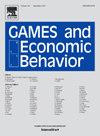投票说服
IF 1
3区 经济学
Q3 ECONOMICS
引用次数: 0
摘要
我们考虑了一个集体说服模型,在该模型中,一个具有私人连续信号的咨询委员会的成员就一项政策变化进行投票。然后,决策者在观察每次投票后决定是否采纳这一变化。当且仅当存在一种信息均衡时,委员会和决策者之间才有可能进行信息传递,在这种均衡中,决策者只有在全票通过后才会采纳政策变化。同样,当且仅当委员会规模足够大时存在这样一个均衡时,完全信息汇总才有可能实现。我们将进一步讨论为什么我们的连续信号模型会产生不同于离散信号模型的结果。本文章由计算机程序翻译,如有差异,请以英文原文为准。
Voting to persuade
We consider a model of collective persuasion, in which members of an advisory committee with private continuous signals vote on a policy change. A decision maker then decides whether to adopt the change upon observing each vote. Information transmission between the committee and the decision maker is possible if and only if there exists an informative equilibrium in which the decision maker only adopts the policy change after a unanimous vote. Similarly, full information aggregation is achievable if and only if such an equilibrium exists when the size of the committee is large enough. We further discuss why our continuous-signal model produces results different from discrete-signal models.
求助全文
通过发布文献求助,成功后即可免费获取论文全文。
去求助
来源期刊

Games and Economic Behavior
ECONOMICS-
CiteScore
1.90
自引率
9.10%
发文量
148
期刊介绍:
Games and Economic Behavior facilitates cross-fertilization between theories and applications of game theoretic reasoning. It consistently attracts the best quality and most creative papers in interdisciplinary studies within the social, biological, and mathematical sciences. Most readers recognize it as the leading journal in game theory. Research Areas Include: • Game theory • Economics • Political science • Biology • Computer science • Mathematics • Psychology
 求助内容:
求助内容: 应助结果提醒方式:
应助结果提醒方式:


